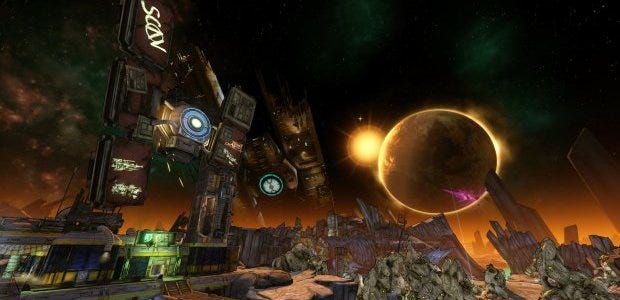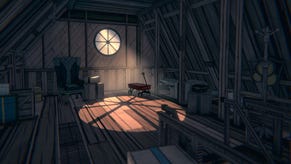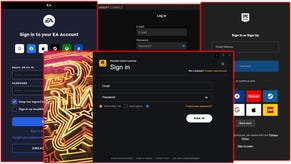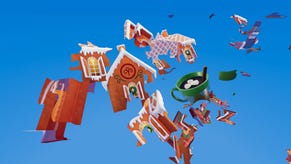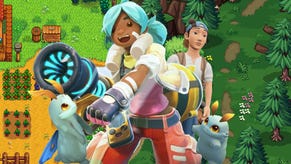Interview: Gearbox On Borderlands: The Pre-Sequel
The Pre-Pre-Sequel Interview
With every new release, the Borderlands universe becomes increasingly ridiculous. It's been happening for a while now, with the puns, the slapstick and the hidden pop culture references that pepper Borderlands 2 and further season its DLC. I'm hardly complaining, because I've gradually disengaged from the first-person shooter over the last few years, confronted again and again by far too many po-faced, monochrome military affairs. Borderlands 2 has been a welcome exception.
Like a sudden burst of ketchup from a thoroughly-spanked Heinz bottle, even more of that often unsubtle flavouring is set to season our PCs very soon. Borderlands: The Pre-Sequel comes out in two weeks. Developed in conjunction with 2K Australia, the Pre-Sequel is exactly what you'd expect from the series: more jokes, more cartoonish violence, more character diversity and a further expansion of a gun collection that would already make any Tom Clancy fan spurt like... well, like a sudden burst of ketchup from a thoroughly-spanked Heinz bottle.
The Pre-Sequel is set on a rather antipodean interpretation of Pandora's moon Elpis and I got to taste a small slice of that moon at 2K's Windsor office a little while ago. It looks, responds and retorts exactly like Borderlands 2 and is very much the younger sibling copying its older brother's playful attitude. For me, this meant it felt just as fun and just as funny, but if Borderlands 2 didn't make you smile, this won't either.
We got to try a few of its new tricks up there on that moon, all of which happened when we stepped into any outdoor environments. Immediately obvious was the new, lower gravity, which transforms you into a sort of Rambo-cum-Neil Armstrong, each jump sending you into a slow-motion leap heavenward. It turns combat into something of a bulletstorm ballet, with players and enemies arcing through the airless sky. I'm not sure it's anything revolutionary, but it certainly adds some physical comedy to the proceedings, particularly whenever anything explodes or when slain enemies erupt with gifts for you. Money bursts over a wide area. At one point, a vital item fragment we needed to make progress actually exploded a little too far, flying off a ridge way out of reach and prompting a quick reload.
Combined with the jetpacks, though, this does become rather more fun, since these give you much more of a sense of flight and of freedom, turning levels from giant trampolines into vistas that you can glide across. These Jetpacks are connected to the new oxygen mechanic, something that works rather like a time limit and which again kicks in as soon as you step outside. An O2 gage gradually ticks down, replenishing the moment you return indoors, but activating your jetpack depletes oxygen quite rapidly. Run out of air and, naturally, it's not going to be good for your health. The amount of fun you can have flying about depends just how much you need to breathe for the next few minutes.
Oxygen considerations also make headshots against enemies even more deadly, as they can shatter helmets and cause rapid asphyxiation. Almost as dangerous are the new ice-based weapons, which freeze enemies and make them both more vulnerable and less dangerous.
But while all these additions were amusing, The Pre-Sequel was extremely familiar. The vacuum vistas I bounced across looked a lot like many of those in Borderlands 2, only dusty rather than icy, with a little more of an outback feel that came more from the many Australian accents than any dramatic redesigns. The new vault hunters were interesting, particularly the sassy Claptrap, but exactly how interesting they are is still to be seen.
Nevertheless, I laughed. We crowned our short co-op session with repeated attempts to complete a ridiculous quest that mostly involved pretending to be a basketball. The idea was that one of us should be able to use the moon's lack of gravity to launch themselves through a basketball hoop. Bonus points would be awarded for flying through the basketball hoop while on fire, suffering for their art, and it's with great sadness that I must admit that I wasn't the flaming Claptrap who popped a perfect three pointer. I won't tell you exactly what happened next, only that it was one of the stupidest and funniest things I've seen in the Borderlands universe.
I will tell you what happened after that, however, and that was my scoring a Gearbox three-pointer by sitting down for a chat with a trio developers - designer Stephen Mander-Jones, producer James Lopez and product manager Chris Faylor - to talk about diversity, shades of [moon] grey and about what it was like making a down-under-flavoured moon up there in Pandora's sky. These were our words:
RPS: There's quite an Australian flavour to this Borderlands. Is that just the result of where it's been made?
Mander-Jones: Sort of. It also helps that it's set on Pandora's moon, so it's like a different part of the Borderlands universe. It makes sense that maybe a different kind of people might live there, so we thought, why not make them Australian?
RPS: A different place, but also a very different time, with different angles on the plot. But first, what kind of Australian angle did you bring to things?
Mander-Jones: There's definitely a lot of humour that's quite different. Some of it might confuse people, some of it might just be hilarious. I think that's one of the great things we bring to it. A lot of the enemies or NPCs or quests are just styled to be kind of Australian and it brings quite a lot of flavour to it. We had a lot of fun coming up with those things and it wasn't necessarily just the writers who came up with them. We let anyone who had cool ideas, as long as they were funny and Australian, put something in the game. We took all those suggestions on board and all the coolest things ended up in there.
RPS: It seems like a good opportunity to represent that. We don't seem to see that many Australian characters in video games lately.
Mander-Jones: Yeah, there's not too many. I think most people get confused by the accent.
Lopez: It's exciting to have a little more diversity in the Borderlands universe. For the most part, we've heard typically American accents and a little bit of a British smattering here and there, but not really much of anything else and not a lot of other groups represented. Early in the development of the Pre-Sequel, 2K Australia was doing proof-of-concept missions by putting in temporary VO [voice-overs] and as we were hearing those accents in there, we started thinking “The moon definitely needs this.” We're excited to add it because it makes the Borderlands universe all the richer for it.
Mander-Jones: It also helps reinforce that you're off Pandora. You're somewhere foreign, populated by a different kind of people.
RPS: Borderlands is more colourful than most shooters, it's full of unusual characters, and there's a deliberate attempt to be inclusive. There's a lot of discussion about this in Anthony Burch's [Borderlands 2's lead writer] post about diversity. Is this something that you're deliberately doing from now on?
Lopez: I think it feels very natural to us, because our development environments feel very diverse. I think it's also very important for us that we avoid a homogeneous universe, you know? Partly just because we have the ability to not make that, but I think it's much more fun for players. One, because there might be a character in there that they can relate to, and two, because it really mixes things up. It keeps you from that feeling that our game is the same as the next [one]. We don't want the franchise to stagnate.
Mander-Jones: I think Borderlands has also established itself as a universe where you don't just have preconceived ideas like “That guy's another big strong man, he's the one who's going to beat me up.” You can get your ass kicked by a female Crimson Lance Assassin, or a team of tiny robots. Anything is potentially a threat.
In the Pre-Sequel, we have quite a diverse selection of vault hunters: two females, a robot and a cyborg. I wouldn't say we actively went out of our way to establish that, because those characters came from another part of Borderlands already. Borderlands just naturally presents itself with those kinds of opportunities.
RPS: An interesting thing about your plot, because of when you've set the game, is that we're seeing characters potentially turn into bad guys. We're seeing a kind of transition, following the development of those characters from an earlier point in their lives.
Mander-Jones: You don't necessarily identify them as clear-cut bad guys. The thing about the Pre-Sequel is, it might make you question some of those things that made you previously think [Borderlands 2 characters] were or are bad guys. As you experience some of those things first-hand, you're going to question them, you're going to say 'Hey, they actually had some pretty good motives, I'm not a hundred per cent sure how I feel about that now.' It's an interesting spin on the storyline.
Lopez: And that's a great point. [Handsome] Jack is clearly the bad guy in Borderlands 2, but even he had a rationale. You could kind of see what he was saying, but mass murder is obviously not the right answer! We play that up more in the Pre-Sequel. We take a person who's fairly, decent, even good, and ask what the events are that make them go down that path. In the Pre-Sequel we've got characters that you'll know you have to fight in Borderlands 2, that are villains, but they actually save the planet. Does that redeem them from their later actions? I don't know, but I think that's a cool idea for us to put out there and for people to debate.
There's a funny thing about the characters you play as. The vault hunters are the protagonists, you're playing as them, but they're actually very violent creatures out for money and loot. The funny thing is, whenever you see anyone in the distance who's dressed like a bandit, you immediately kill them. You go 'Oh, he's a bandit, so I've got to kill this guy.' But that, in and of itself, is a very morally questionable decision.
In Borderlands 2, Axton is actually very questionable because he's a glory-hard-on kind of guy, but because you're fighting Jack, it's put in this very positive light. But if you met a vault hunter in the wild, you'd probably have to stay away from them. Everyone dies around a vault hunter. It's a very strange universe that they live in. [It's worth noting that Axton has a massive bounty on his head for committing war crimes.]
RPS: It feels like, with Borderlands, you guys design missions and plots based around personalities, personal motivations and, perhaps now, with considerations of shades of grey. Is that harder? It's more interesting for you, surely?
Lopez: We're a different genre in some ways, because we're not a military shooter. I think that gives us a flexibility to do things, an option for other themes. There are so many different things that we want to try in our games that we always try and find new ways to execute them. We've got people that really enjoy making platforming puzzles, so there are platform puzzles across all the maps. That Space Slam mission, there's an easy way to get around that takes longer, or there's a harder way that, if you nail it, you can solve it much faster. And it's there just because! It's kind of stupid, but it's a lot of fun.
RPS: Gearbox have a couple of different franchises they've really focused on the development of. Brothers in Arms was around for a long time and Borderlands has aged very well. I've been to see Battleborn, to see Randy Pitchford and Randy Varnell, who were both very much on message saying that they liked creating new universes, but also moving on from them when they got stale. Do you have an idea how long Borderlands will run for? Of how many stories you want to tell?
Lopez: Hopefully for as long as we can entertain people.
RPS: The thing is, Star Wars has been going for a long time now and it feels tired. There's so much Star Wars everywhere that it's lost what made it exciting. Is that not a fear that you have?
Faylor: That's a big part of game design. Is this fun? Is this fresh? Are we doing right by our franchise, by our consumers? One, we have very talented people working on this, we've got the guys who made BioShock and that's awesome. We've got guys who've been working on Borderlands for almost a decade. Two, we have this fantastic user research team, lead by Jonathan Cohen and they're really good at what they do. They're very good at gleaning answers from our fans and even from people who aren't fans to find out what it is that we can do to make this more fun.
It's definitely a concern to us, that our stuff might feel recycled, and we don't want that.
Mander-Jones: That's a big thing in how the Pre-Sequel has turned out. A huge motivation for what it is is what fans want. Since Borderlands 2, fans have been saying things like 'We want to go to the moon,' 'We want to go to the Helios station.' It's pretty simple stuff to say that we'll give that to them, then we ask what opportunities that gives us to really change up the game, whether that's low gravity or oxygen mechanics. We're in space, so we should have lasers. Let's have new elements, like ice. If fans are really asking for these things then, all right, we're going to make them. If it's what they want, they're going to enjoy it more.
RPS: I think there was a discussion a few years back about Doctor Who and about how the showrunners were not going to listen to people on the internet because there were too many different things to be listening to. Do you feel happy, then, letting fans pull you in the direction they want?
Lopez: To a certain extent, yeah. Fans can have great ideas. We're not foolhardy enough to think that we have all the answers and that only we have the answers to what Borderlands can be. There are some things that we'd never try, there are ideas out there that aren't so great, but we know that there's good ideas out there worth doing. We regularly poll people at community events, which are these things we do in Dallas and where we just ask “What do you think about this? What do you think about that?” We have one-on-one discussions and get some really cool ideas and criticism out of them.
Faylor: Our user research team is really skilled at discerning signal from noise. Sometimes a complaint isn't indicative of its root symptom. One of my favourite stories about this is from the first Borderlands, where somebody complained that the movement was too slow. Our development team thought that was a really good point, so they put more trash on the ground. Next test? Yeah, it feels great! It was just a visual quirk.
There was also a moment with Skag Gulley where users complained that there were too many enemies. We tripled the amount of enemies in the area, so the perception that this was a zone to be travelled through with just a smattering of combat was removed. This is now a full-fledged combat zone. That's its purpose.
It's all very much about critical thinking, about saying that there's always very much something in, say, a criticism, but maybe that criticism or suggestion could be addressed or solved in an indirect or original way.
RPS: Obviously, Borderlands is full of hidden references and jokes about all sorts of things, from famous quotes to Minecraft creepers. Without spoiling too much, is there anything particularly good we should try and seek out?
Lopez: Much to the chagrin of our legal team, there's are plenty of jokes that we have in the game.
RPS: Is that a serious problem?
Lopez: No, it's more that if we're going to make a joke about Minecraft, you need to make sure that you're playing fair.
Mander-Jones: Yeah, and it's always done in a positive manner.
Faylor: The Minecraft easter egg, for example, was cleared through Mojang and done with their collaboration. You can actually see it there in the legal text for the game.
RPS: Is that really a thing you need to do? Surely there's the law of fair use for parody, especially in the United States.
Faylor: Well, considering how excessive that Minecraft easter egg was, to the point of recreating certain characters... Plus, if you're going to do something like that, you want to do it with the blessing of the creators, right?
RPS: Like Weird Al's thing, where he always gets in touch with people to ask if he can parody their songs.
Faylor: Yeah, legally he doesn't have to, but he does it anyway.
Lopez: Anthony [Burch] actually made a lot of fun of himself in the Pre-Sequel, because he had so many memes that he either uses because he loves them or because he hates them. When you finally get to the Helios space station there's this hall of Claptraps and each one has a random call-out. A lot of them are jokes about game development, about the process, about going into meetings too often versus making the game, but there's also a couple of times when Anthony's making fun of himself. I don't want to spoil the joke, but people should definitely take the time to go around and interact with each Claptrap. They're all very funny.
RPS: Do all the jokes take over? Do you find that design leads story, or that story leads design? Are you more excited about making something that's very challenging, or about just making something that's very funny?
Mander-Jones: It's a mesh of all of those. Sometimes you might get a broad overview of a narrative and then work with that on design. Throughout the whole process you've got both disciplines involved.
Lopez: We do often look at things and go “Y'know, this is fun gameplay, but the story here just isn't fun,” You do a lot of zooming in to those points and then zooming back out to check the bigger picture.
Faylor: What was that email chain that went around, the one that was about Anthony's favourite mission? The designer worked on the mechanics for the mission, then a designer on another team saw it, said 'Oh man, that's a really funny mission, I want to make an addition' and suddenly it was snowballing and snowballing, through all our different departments, and when somebody saw what somebody else had done, they got motivated by how cool it was, and it kept on snowballing. It became this really big, awesome thing that half the team had collaborated on, because they were just so excited about the potential of it.
Lopez: It's not like we say that we need ten plot missions, and for each plot mission we need three side missions. It's not anything nearly so dry. We try to have a lot of space for things and time to be creative. We had a big, open, hidden space [on the map] we just weren't using. Someone said we could just cut it out, but instead we could keep the space as it was, tucked away like it was, but make it so that you had to go all the way across the map and then around a corner to find it. Then, we could put something really funny and really silly in there.
RPS: You describe ideas bouncing around the office, or snowballing, but that's not always how video game development goes. Producers tell you what to make and that you have a certain amount of time to make it in. Are you just looser in how you work?
Mander-Jones: No, there's a truth in what you've said. It's normally when the producers tell us to stop that we do, but up until that point it's all about that. Borderlands is such a wacky universe that you can't just plan out those things. They need time to form. Anyone on the team can contribute to ideas, to bounce them around. We're aware that things need to get done and that there's a point where you can no longer change things, but we always make sure that we have time to develop ideas.
Lopez: As a producer, I do look at the calendar a lot. I look at our contracts and at our milestone goals to make sure that we're respecting that, otherwise we aren't doing our job. As a developer, or as part of a development team, I also have to make sure that my team are creatively satisfied. As long as they're respecting the timeline, as long as we're doing the things we need to be, it's fine for them to play around. Some of our best work comes out of that freedom. Whenever they've got an idea, I go [mimes a schedule] “Okay, so where's this fit in here?” and they go “I can do it right after this.” Everyone understand it's not always a guarantee, that it might not work or we might have to cut it, but our team put in a lot of effort to make their ideas work and the game has always benefited from that looser approach.
RPS: Thank you very much.
